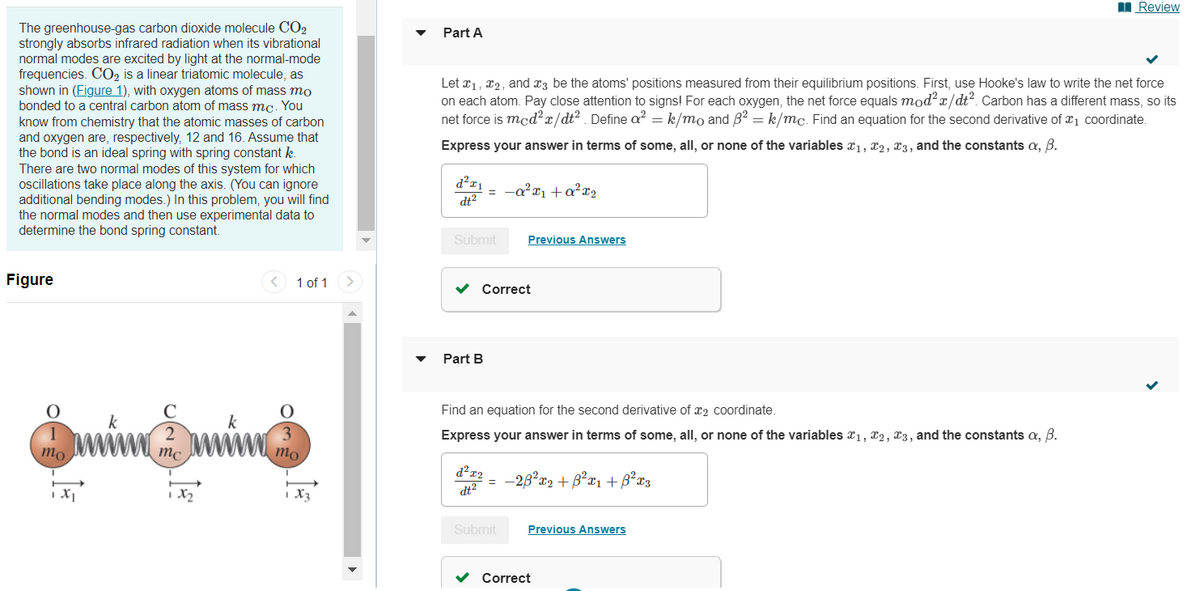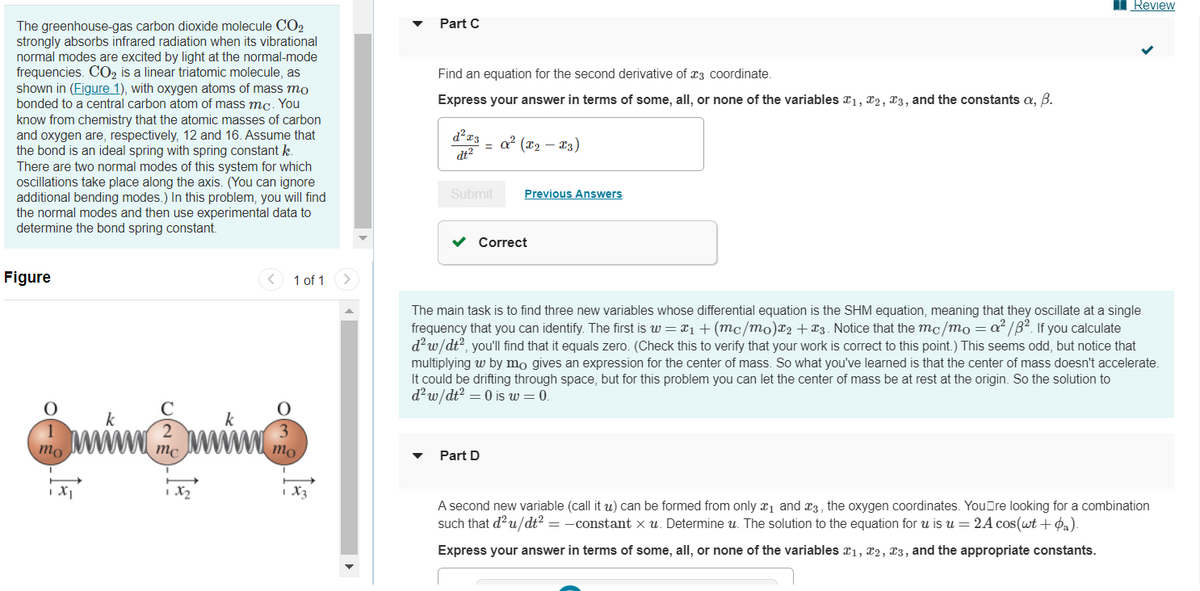The greenhouse-gas carbon dioxide molecule CO2 strongly absorbs infrared radiation when its vibrational normal modes are excited by light at the normal-mode frequencies. CO₂ is a linear triatomic molecule, as shown in (Figure 1), with oxygen atoms of mass mo bonded to a central carbon atom of mass mc. You know from chemistry that the atomic masses of carbon and oxygen are, respectively, 12 and 16. Assume that the bond is an ideal spring with spring constant k There are two normal modes of this system for which oscillations take place along the axis. (You can ignore additional bending modes.) In this problem, you will find the normal modes and then use experimental data to determine the bond spring constant.
The greenhouse-gas carbon dioxide molecule CO2 strongly absorbs infrared radiation when its vibrational normal modes are excited by light at the normal-mode frequencies. CO₂ is a linear triatomic molecule, as shown in (Figure 1), with oxygen atoms of mass mo bonded to a central carbon atom of mass mc. You know from chemistry that the atomic masses of carbon and oxygen are, respectively, 12 and 16. Assume that the bond is an ideal spring with spring constant k There are two normal modes of this system for which oscillations take place along the axis. (You can ignore additional bending modes.) In this problem, you will find the normal modes and then use experimental data to determine the bond spring constant.
Related questions
Question
NOTE: Parts A and Part B and Part C are already included. I need help with Part D. That is why I included Parts A, B, and C. What is the solution to Part D?

Transcribed Image Text:The greenhouse-gas carbon dioxide molecule CO2
strongly absorbs infrared radiation when its vibrational
normal modes are excited by light at the normal-mode
frequencies. CO₂ is a linear triatomic molecule, as
shown in (Figure 1), with oxygen atoms of mass mo
bonded to a central carbon atom of mass mc. You
know from chemistry that the atomic masses of carbon
and oxygen are, respectively, 12 and 16. Assume that
the bond is an ideal spring with spring constant k.
There are two normal modes of this system for which
oscillations take place along the axis. (You can ignore
additional bending modes.) In this problem, you will find
the normal modes and then use experimental data to
determine the bond spring constant.
Figure
mo
k
2
mc
1x₂
k
<
1 of 1 >
3
mo
X3
Part A
Let x₁, x2, and 3 be the atoms' positions measured from their equilibrium positions. First, use Hooke's law to write the net force
on each atom. Pay close attention to signs! For each oxygen, the net force equals mod²x/dt². Carbon has a different mass, so its
net force is mcd²x/dt². Define a² = k/mo and ß² = k/mc. Find an equation for the second derivative of ₁ coordinate.
Express your answer in terms of some, all, or none of the variables ₁, 2, 3, and the constants a, ß.
d²x₁
dt²
Submit Previous Answers
= -a²x₁ + a²x₂
✓ Correct
Part B
Find an equation for the second derivative of 2 coordinate.
Express your answer in terms of some, all, or none of the variables ₁, 2, 3, and the constants a, B.
d²x2
dt²
=
Submit
-23²x₂ + ß²x₁ + ²x3
Previous Answers
Review
Correct

Transcribed Image Text:The greenhouse-gas carbon dioxide molecule CO2
strongly absorbs infrared radiation when its vibrational
normal modes are excited by light at the normal-mode
frequencies. CO2 is a linear triatomic molecule, as
shown in (Figure 1), with oxygen atoms of mass mo
bonded to a central carbon atom of mass mc. You
know from chemistry that the atomic masses of carbon
and oxygen are, respectively, 12 and 16. Assume that
the bond is an ideal spring with spring constant k.
There are two normal modes of this system for which
oscillations take place along the axis. (You can ignore
additional bending modes.) In this problem, you will find
the normal modes and then use experimental data to
determine the bond spring constant.
Figure
O
1
mo
X₁
k
C
2
mc
X2
k
< 1 of 1
3
mo
1 X3
Part C
Find an equation for the second derivative of 3 coordinate.
Express your answer in terms of some, all, or none of the variables ₁, 2, 3, and the constants a, B.
d²x3
dt²
=
Submit
a² (x₂-x3)
Part D
Previous Answers
Correct
Review
The main task is to find three new variables whose differential equation is the SHM equation, meaning that they oscillate at a single
frequency that you can identify. The first is w = X1 + (Mc/M0)X2 +£3. Notice that the mc/mo = a² /B². If you calculate
d² w/dt², you'll find that it equals zero. (Check this to verify that your work is correct to this point.) This seems odd, but notice that
multiplying w by mo gives an expression for the center of mass. So what you've learned is that the center of mass doesn't accelerate.
It could be drifting through space, but for this problem you can let the center of mass be at rest at the origin. So the solution to
d² w/dt² = 0 is w = 0.
A second new variable (call it u) can be formed from only ₁ and 3, the oxygen coordinates. You are looking for a combination
such that d²u/dt² = -constant xu. Determine u. The solution to the equation for u is u = 2A cos(wt + a).
Express your answer in terms of some, all, or none of the variables ₁, 2, 3, and the appropriate constants.
Expert Solution
This question has been solved!
Explore an expertly crafted, step-by-step solution for a thorough understanding of key concepts.
This is a popular solution!
Trending now
This is a popular solution!
Step by step
Solved in 2 steps
